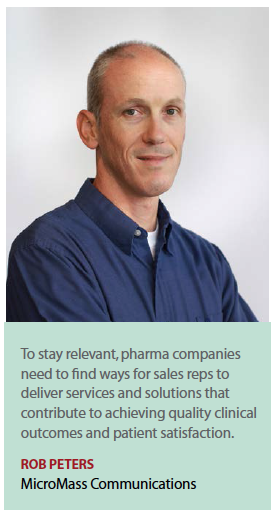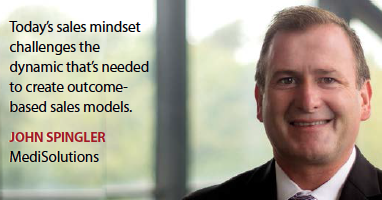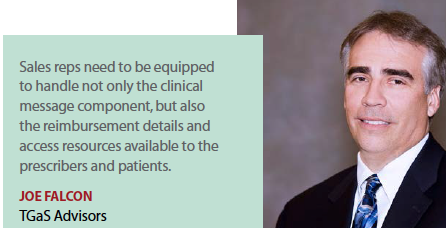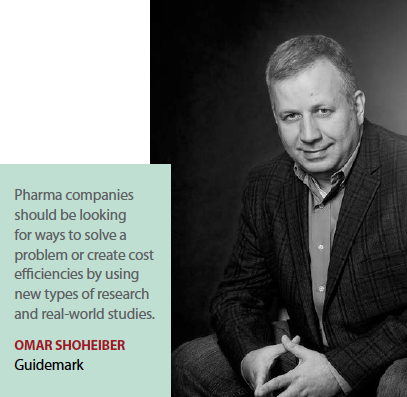According to a recent report by Accenture, three factors — reimbursement models, changing buyer profiles, and digital capabilities — are changing the pharmaceutical and healthcare industries and directly impacting the traditional pharmaceutical sales rep model. However, these factors also represent opportunities for the industry to reinvent the sales team from being product sellers to “outcomes advocates," sales reps who provide services that impact the entire spectrum of patient care. To accomplish this transformation, sales reps will need to broaden their focus to include other healthcare stakeholders, as well as acquire new skills, learn to integrate digital technologies into their sales process, and become part of the solution to improving patient outcomes.
 “In today’s healthcare environment, there is more pressure to deliver optimal patient outcomes with greater efficiency," says Rob Peters, senior VP, strategy, MicroMass Communications. “To stay relevant, pharma companies need to find ways for sales reps to deliver services and solutions that contribute to achieving quality clinical outcomes and patient satisfaction. Traditional data dissemination and brand message approaches are not enough to provide a noticeable impact."
“In today’s healthcare environment, there is more pressure to deliver optimal patient outcomes with greater efficiency," says Rob Peters, senior VP, strategy, MicroMass Communications. “To stay relevant, pharma companies need to find ways for sales reps to deliver services and solutions that contribute to achieving quality clinical outcomes and patient satisfaction. Traditional data dissemination and brand message approaches are not enough to provide a noticeable impact."
There has already been a slight shift toward a more service-oriented sales team model, and some sales agents today are delivering value to physicians in the form of patient reimbursement programs and other value-added programs, says John Spingler, solutions consultant, MediSolutions. But focusing on the physician does not go far enough these days. Reps need to look beyond the doctor’s office to the broader network of buyers and influencers.
“The average sales representative today uses a variety of solutions — co-pay cards, reimbursement programs, and so on — to impact the patient," Mr. Spingler says. “But drug companies need to enable and address a bigger data set that exists beyond the label itself. They need to really take a bigger picture view."
Today, sales reps need to understand how to deliver value, and in turn, develop a more solution-oriented approach to meet the challenges that physicians and patients face.
One hurdle to this approach may lie within the walls of the company. According to Mr. Peters, in-house regulatory departments need to acknowledge that sales reps can and should deliver more than just a repetitive brand message.
“Pharma companies have an opportunity to let sales reps build a solid clinical background and provide more of a holistic perspective, rather than strictly a sales approach," he says.
 Both evidenced-based medicine and the ability of sales reps to make that evidence relevant to the prescriber, healthcare staff, and their patient population are growing in importance, says Wendy Wolf, senior VP, U.S. commercial operations, Ashfield Commercial. Managed care, payers, and government entities are driving treatment decisions at the highest rate in history and this pattern will continue to grow. Knowing the payer landscape, navigating the system, and ensuring patient access in light of increased reimbursement services, must be tightly linked and understood by sales reps for them to be successful in delivering the benefit message to the patient.
Both evidenced-based medicine and the ability of sales reps to make that evidence relevant to the prescriber, healthcare staff, and their patient population are growing in importance, says Wendy Wolf, senior VP, U.S. commercial operations, Ashfield Commercial. Managed care, payers, and government entities are driving treatment decisions at the highest rate in history and this pattern will continue to grow. Knowing the payer landscape, navigating the system, and ensuring patient access in light of increased reimbursement services, must be tightly linked and understood by sales reps for them to be successful in delivering the benefit message to the patient.
“Outcomes are driving choice more than ever before," Ms. Wolf says. “The bottom line is always the value equation for physicians: does a brand bring value to my practice, my staff, and my patients? Is it going to bring more value than the competition, even when the competition is generic and is pennies on the dollar vs. the branded drug?"
 Ms. Wolf says if the answer is yes to those questions — and this is communicated effectively, efficiently, and with the right amount of frequency via the proper channels — then the outcomes for all involved will be positive. But if there is even one gap or weak link in the equation, then the risk of failure is high, she adds.
Ms. Wolf says if the answer is yes to those questions — and this is communicated effectively, efficiently, and with the right amount of frequency via the proper channels — then the outcomes for all involved will be positive. But if there is even one gap or weak link in the equation, then the risk of failure is high, she adds.
Another challenge lies within the trend of more and more physicians giving up their private practices and becoming part of a larger healthcare organization. In today’s environment, sales reps are rarely selling to one person anymore. According to Omar Shoheiber, chief market access officer at Guidemark, this new sales environment will require reps to understand the healthcare provider organization as a whole, including the structure of the organization, its business model, and its customers.
“Once reps have the full picture, then they can better determine where they and their products fit in to the overall business model of the organization," Mr. Shoheiber says. “And this is quite a process and more complex than it used to be."
Traditionally, if a company deployed a field sales team and had the sales reps stick to the three Rs — right message, right number of times, to the right target — the company would have a sure win, Ms. Wolf says.
“In our current market, this strategy is flawed," she says. “The end goal is basically the same, but the journey to get to that ‘3R moment’ has changed and requires modifications to the way sales reps are hired and trained, and how they interact with their customer base. To keep sales reps relevant in our marketplace we need to start with the end in mind. What is the current value equation? What will it be as we move forward? Once we answer these questions, we can better understand how to make the value equation work for brands and customers."
Pharma companies should be looking for ways to solve a problem or create cost efficiencies by using new types of research and real-world studies to create a service or a combination of products and services that touch on all stakeholders, Mr. Shoheiber says. He provides this example: A chemotherapy treatment has a significant dropout rate after the second dose due to side effects, and it takes at least four or five doses for the patient to realize any benefit from the treatment. The drug manufacturer needs to approach the marketplace with patient education and support programs that will help patients who start on therapy reach that fourth, fifth, and even the sixth dose.
Collaboration with specialty pharmacies is also key, as well as working with payers, perhaps offering to pay the cost of the drug for those patients who drop out after the first or second dose.
“This is an example where the pharma industry is collaborating and supporting patients, the payers, and the providers," he says. “It’s a win-win-win approach."
In terms of reimbursement, pharma companies have been dedicating significant resources to identifying which payers are ready, willing, and capable of jointly developing value-based pricing agreements. Another example is the restructuring of account management teams to include resources trained and dedicated to work with payers and integrated healthcare systems in developing successful outcomes based contracts.
 “Working in a coordinated fashion with account management, managed markets marketing, brand, market research, and sales operations teams, salesforces can focus on hospital administrators, P&T, and quality management officers who also now have increased influence on product reimbursement," says Joe Falcon, senior VP, commercial, TGaS.
“Working in a coordinated fashion with account management, managed markets marketing, brand, market research, and sales operations teams, salesforces can focus on hospital administrators, P&T, and quality management officers who also now have increased influence on product reimbursement," says Joe Falcon, senior VP, commercial, TGaS.
According to Accenture’s report, The Rebirth of the Pharmaceutical Sales Force, collaboration within companies is imperative, as well. Coordination between sales and non-sales functions is critical and requires the sales organization to work with marketing and other functional areas to develop tools, services, and programs that stakeholders will value. Companies must reevaluate the marketplace to identify opportunities for the sales organization to add value, while ensuring they don’t introduce regulatory and compliance risk.
“There are quite a few innovative companies out there that have some powerful solutions," Mr. Spingler says. “However, industry adoption of new technology channels is really slow, in part driven by the uncertainty of the new."
In today’s world — call it the post-corporate integrity agreement era – it’s all about compliance, he explains.
“Compliance is at the heart and soul of what drives companies today," he says. “This mindset challenges the dynamic of what’s needed to create the desired state where we can really see outcome-based sales models emerging. To get there, the people working in the industry need to incorporate structure- and system-thinking into their day-to-day activities."
New Skills for Reps
The sales rep role of today should go far beyond the product sell. Reps must be prepared to sell and service large physician organizations by understanding the challenges, the aspirations, and the business model of the organization and structure the offerings to meet the need of the marketplace today. This shift to a more service model may not bode well for veteran sales reps, who are comfortable with product selling and a features-and-benefits strategy.
 “Frankly, the challenge pharma companies are facing is that the average pharma sales rep is not well-equipped for this new model," Mr. Shoheiber says. “That’s why companies are increasingly relying on specialist salesforces. Whether these are in the form of an MSL salesforce, a nursing team, or a specialty team, this approach tends to be more successful than the legacy product sales teams. The rep that goes in and already understands the challenges and needs of that organization and can identify areas of joint interest, areas of joint priorities where he or she can offer products and services to help that organization, that person is going to be successful."
“Frankly, the challenge pharma companies are facing is that the average pharma sales rep is not well-equipped for this new model," Mr. Shoheiber says. “That’s why companies are increasingly relying on specialist salesforces. Whether these are in the form of an MSL salesforce, a nursing team, or a specialty team, this approach tends to be more successful than the legacy product sales teams. The rep that goes in and already understands the challenges and needs of that organization and can identify areas of joint interest, areas of joint priorities where he or she can offer products and services to help that organization, that person is going to be successful."
Sales representatives need to be equipped to handle not only the clinical message component, but also the reimbursement details and access resources available to the prescribers and patients, Mr. Falcon says.
“The clinical and economic components of meaningful outcomes-based solutions accentuate the need for sales representatives to focus on earning the trust of the prescribers through the one-on-one articulation of timely and relevant clinical and patient-centered real-world benefits versus standards of care," he says.
Strategic selling requires that sales reps understand all of the stakeholders and their individual and collective influence on prescribing decisions. Training reps to have a deeper understanding of the decision flow and who is involved in the process, as opposed to the historic focus on the physician alone, is necessary, because the profile of the rep has changed dramatically over the years, Ms. Wolf says. The challenge is finding reps with the skills to gain access to stakeholders and establish the value of the brand; as a result, additional time must be spent sourcing exactly the right talent. Terms such as “business builder," “hunter," “entrepreneurial thinker," and “service-oriented" are more and more common in rep profile discussions to ensure the skills needed are there from day one. This also means the typical experience required is not so typical anymore — business-to-business selling, experience with a startup, service industry experience, coupled with experience in healthcare is more and more common now, she says.
Outcomes-Based Selling Changes Sales Strategies
Pharmaceutical sales teams preparing to shift to a more outcomes-based model will need to use digital technologies to provide services to customers in ways they never have before. The industry should be working on how to use digital technologies to make salesforces more relevant than ever, Accenture reports. Sales reps already use mobile, but there is more opportunity to add value by embracing the other multitude of sources for real-world evidence, which can create a much different conversation with the physician — one that combines clinical science and social science.
“The biggest change is a shift away from the personal relationship to one of digital delivery of scientific information," Mr. Spingler says. “In other words, there’s less face-to-face rep time and more digital communications taking place today."
There is also more potential to use real-world evidence that comes from multiple sources, such as patient-reported outcomes and data collected from wearables. Using the Internet, mobile, and wearable devices, healthcare companies can now create positive feedback loops for patients.
“This is quite a change from the one-size-fits-all era of medicine that we’ve been living in over the past couple of decades," Mr. Spingler says. “Digital technologies and patient-reported outcomes and real-world dynamics can really impact and change salesforce strategies in healthcare today."
The challenge is to create a platform that helps manage and analyze the data now available, and use that data to shape the sales presentation and services connected to the product.
“Systems thinking and a holistic perspective are requirements for tomorrow’s healthcare leaders," Mr. Spingler says. “They need to create a system to incorporate big data into their story, and they need to be willing to take some risks and create a conversation that incorporates the real-world outcomes that are now achievable and actionable given the technologies and the data sources that exist beyond just a clinical trial."
Another opportunity for sales reps to provide value occurs when a drug requires companion diagnostics. Providers need to be educated about these companion diagnostic tests and the systems need to mature so that physicians can easily adopt these tests within the process of care.
“This is an opportunity for industry to be the enabler of education about companion diagnostics as a bigger part of the drug story," Mr. Spingler says. “This is an emerging sales strategy that’s being seen more and more in precision medicine and it can save a lot of money and increase the quality of life for patients."
A tailored approach to sales is a term that has been used for years, but it has become mission critical now. This means when deploying a sales rep, all available resources must be used to formulate the value-delivery plan — data, payer teams, internal subject matter experts, local knowledge, and more. A tailored plan powered by this consolidated information will improve the rep’s relevance and performance.
“Customer-focused selling means knowing what matters — and more importantly, knowing that what matters to some doesn’t matter to others," Ms. Wolf says.
When thinking about customer focus, office disruption matters more than ever before. The Affordable Care Act is driving millions more people to actively seek medical services, so physician and staff time are increasingly tight. Any disruption via a live rep, virtual detail, or a telesampling phone call are all seen as a disruption — unless the delivered value is greater than the time spent away from patient care.
Mr. Peters says pharma companies should be providing sales reps with more comprehensive solutions that incorporate clinical and behavioral approaches to achieve more consistent and optimal outcomes. Evidence-based behavioral approaches from health psychology and behavioral science complement clinical approaches and ensure optimal management of patients. These combined approaches can be applied in a practical way through branded patient support programs. Sales reps can then use these programs to deliver value beyond an overused, repetitive brand message.
“Ultimately, if the sales rep is equipping the physician with solutions and programs to facilitate better patient outcomes, then there is going to be continued success for the brand," Mr. Peters says. “The key to increasing the perceived brand value is to show physicians that they can achieve better results with that brand and its associated support. When this happens, the physician will continue to prescribe the brand."
More than ever, market access, marketing, and sales operations functions will have to come together earlier in the development and implementation of truly integrated patient-centered communications and support programs that enable healthcare professionals, administrators, and payers to focus on the achievement of the desired patient outcomes.
“Training and talent emphasizing clinical disease parameters, health economics, assistance programs, and patients’ socioeconomic status are the critical components of all interactions," Mr. Falcon says. “Sales reps are a very important pillar in making these known and available to the healthcare and patient communities." (PV)


















